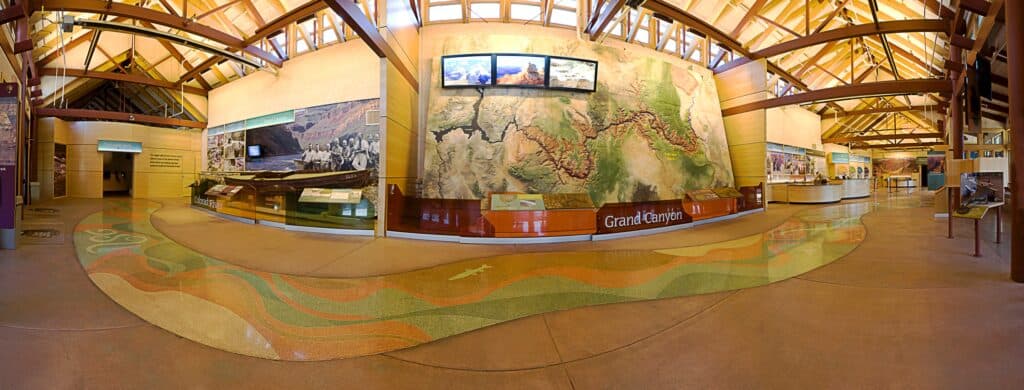If you’ve been camping before, you know that it can be a lot of fun, but it can also get a little boring if you don’t have ideas for things to do.
You can make camping less boring by learning new skills, playing games, and being active. Going exploring, building a shelter, creating a nature journal, doing scavenger hunts, and making creative snacks. You can also learn a new skill like how to ID plants and foraging.
All of the activities on this list are great options for both kids and adults!
Begin a Nature Journal
Nature journaling is a great hobby for both kids and adults. Not only is it a way to record the things you see and keep track of your travels, but journaling is also an amazing tool for teaching people to be better, more careful observers. You have to be able to observe carefully in order to draw or write in detail.
Our kids all keep nature journals as part of their homeschool lessons, but there’s no age limit or style of education that can’t benefit from this activity. If you’re not artistic, you could consider writing your observations, but remember that your nature journal isn’t about art or skill- it’s about recording what you see, and there’s no rule that you have to be an artist to keep a journal. And you will improve with practice!
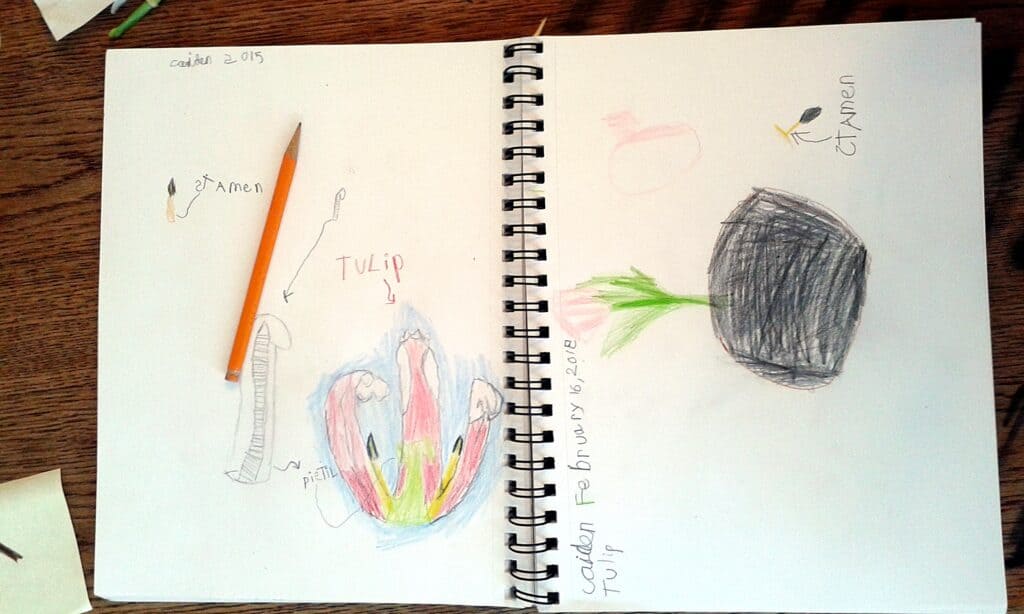
Make a Fun Campfire Snack
Snacks are a great way to keep kids happy. Not only do kids often feel like snacking when they’re bored, but they also expend a lot more energy than normal- We always bring extra snacks when we’re camping, but if you’re in the mood for something fun and unique it might be the perfect time for a campfire snack. Make sure to include your kids in making these fun treats, as the cooking is half the fun.
The most obvious campfire snacks are roasted marshmallows and s’mores. But there are other fun and creative options, such as cinnamon rolls baked in orange peels! Try these options:
- Orange Peel Cinnamon Rolls (or brownies)
- Campfire Cones
- Foil Loaded Fries
- Stuffed Bananas
- Foil Monkey Bread
- Foil Apple Crisp
- Bacon on a stick
- Cinnamon Roll on a Stick
- Campfire Tarts
- Baked Apples
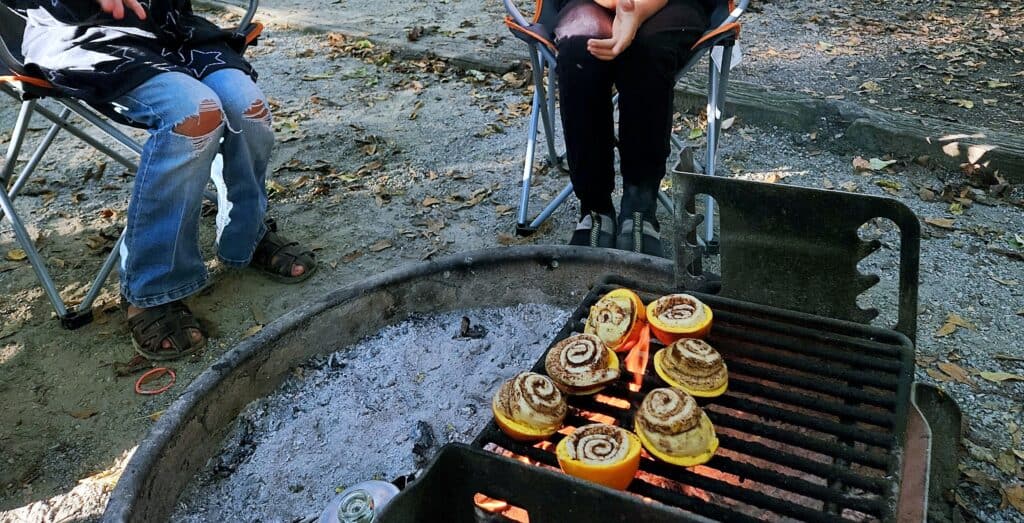
Make Your Own Hike
Hiking is a popular camping activity I wouldn’t want to miss. But if you or your kids are bored and seeking adventure, following a well-marked trail might not be what you’re seeking. Sometimes my family enjoys making our own adventures by exploring somewhere off-trail. We simply find an area that looks interesting and go explore it. We might see a lovely distant meadow and hike to it, or spot a ridge that looks like it has great views and scramble to the top.
If you choose to make your own hike or go exploring off-trail, make sure that you know what you’re doing. First, you need to have a relatively good understanding of the area and navigation so you don’t get lost. You also need to make sure that going off-trail is allowed in the area you’re visiting (in many national parks it isn’t allowed, but it’s acceptable in most national forests.) Finally, make sure you’re prepared with plenty of water, food, and survival supplies, and that you don’t overestimate your own skills.
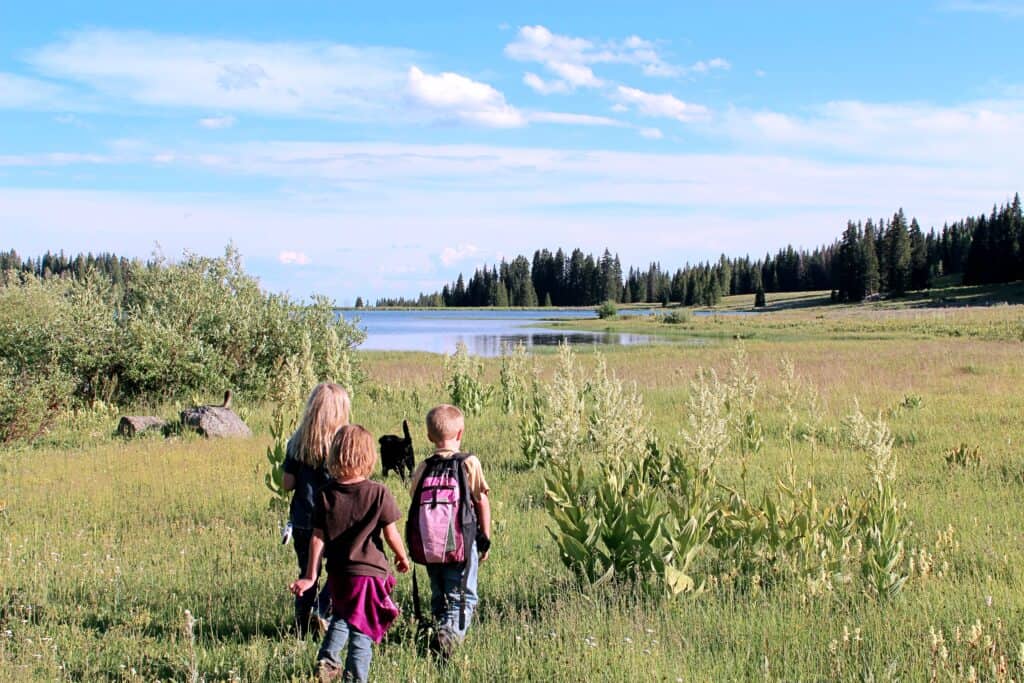
Grand Mesa National Forest, Colorado.
Build a Shelter
If you’re camping in national forest land or other areas where it’s permissible to gather downed branches and wood, try building a shelter. There are several different ways to do this, but the best option is to just get started and experiment. Our kids love building shelters and occasionally have played in shelters built and left behind by others.
If you do build a shelter with your kids, they might want to sleep in it. Our kids have slept in shelters and it’s a great experience. Just make sure their sleeping bags are warm and that they have protection from biting insects.
Finally, while our kids enjoy finding shelters left behind by others, in general it’s best to follow Leave No Trace principles and return the area to the state in which you found it.
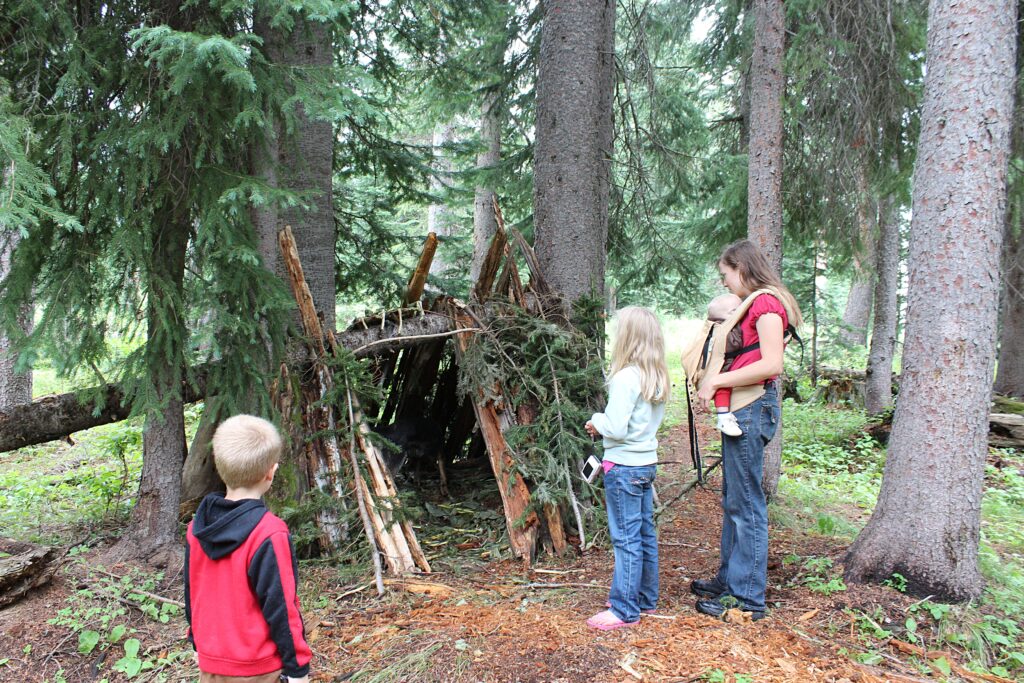
Create a Treasure Hunt
Treasure hunts are fun for kids (and adults- geocaching is popular!) and relatively easy to set up. Use a map or a series of clues to help direct your seekers to the correct area. Make the clues hard enough that they have to work at it (and so the hunt isn’t over too quickly), but keep things appropriate for their abilities so they don’t get discouraged.
If you have adults, little kids, and older kids all wanting to play, design multiple hunts based on their skills or have older folks team up with littler ones. Finally, to make the game more fun, have something worth hunting for as your “treasure” such as a special snack or fun activity.
Practice Orienteering (Teach Your Kids How Maps Work)
Consider using your camping trip to help your kids learn how to read maps. Whether you’re in a public or private campground or in a dispersed camping site, you can easily make a map for your kids and help them learn to know their way around and get better at orienteering. The small area and different roads in campgrounds make this a great place to practice finding your way- many are laid out like little towns.
One way we do this is by drawing a simple map of the area and having our children find specific locations from the map, such as a campground store or playground. We also have our kids find their way home in this way. We walk somewhere together and then hand the kids the map, letting them lead us home (stay with them, of course).
We also do this without maps to help our kids learn to “feel” directions and pay attention to landmarks. Little kids often don’t naturally notice where they are going and how to get back- having them find their own way while you’re nearby to keep them safe is a good exercise in observation and sensing directions.
Try Campfire Bubbles
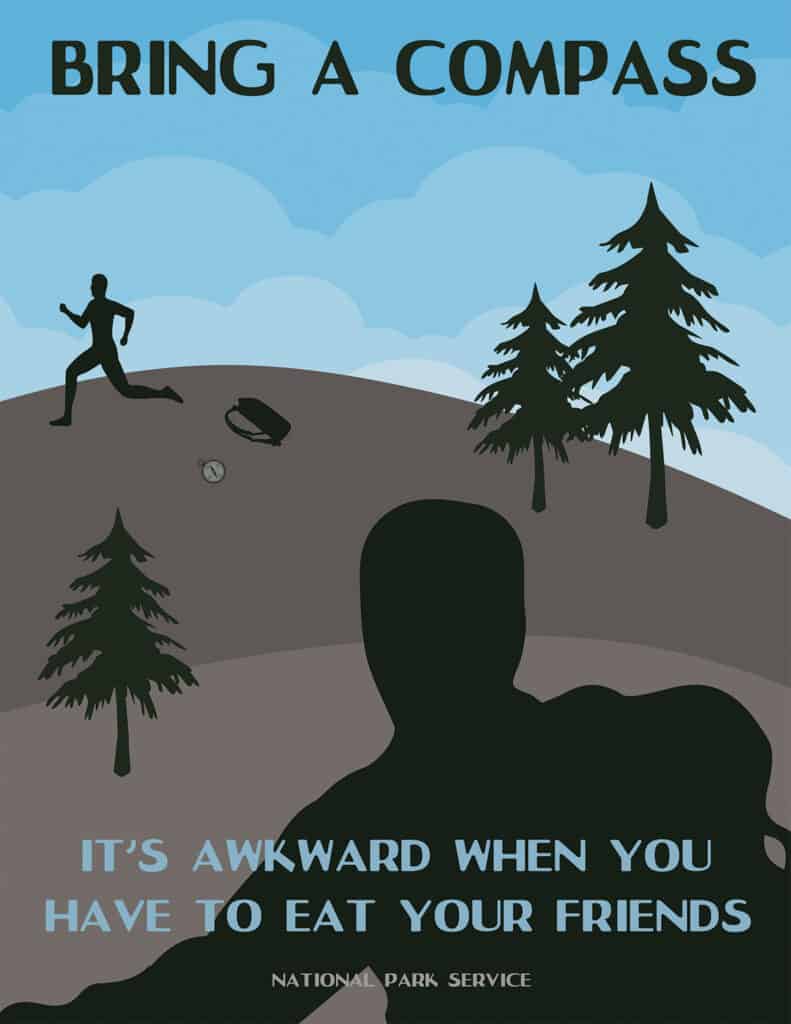
Have you ever tried blowing bubbles over a campfire? If you or your kids are bored and need a quick, silly activity, this is the perfect thing to try. When you blow bubbles over a fire, they rise up much higher because of the hot air from the fire, and for some reason, they seem to be much less likely to pop. Regardless of the reason, blowing bubbles over a fire is a camping tradition in my husband’s family, and now in ours. On your next camping trip, bring several bottles of bubbles so you can try it!
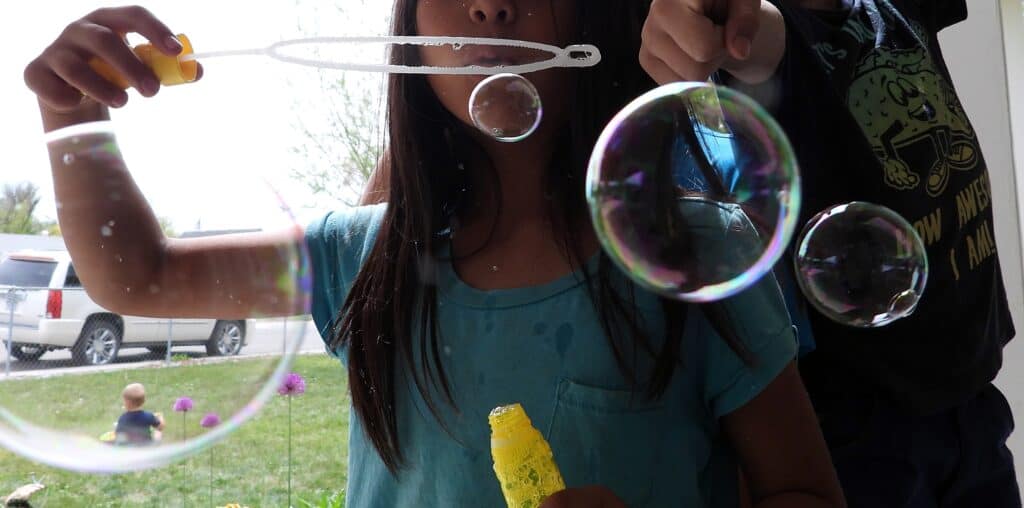
Play a Game
When we’re camping we always seem to have more time for activities like playing games than we do at home. Whether we play more active games like Capture the Flag or board games played around the picnic table, we always enjoy taking a break from hiking and exploring to play some games.
Make sure you bring equipment for active games if your family enjoys them, such as a badminton set or a ball and bat. We also enjoy playing kickball when we can find a large enough area. Spur-of-the-moment games such as tag are also fun and are a good way to wear out kids (and parents!) We have played Capture the Flag with a variety of different makeshift items being used for flags and, occasionally, pine cones become grenades.
For less active options, try to bring along a few card games or small board games. On quiet lazy afternoons, we enjoy sitting around a picnic table or around the fire playing games together. Usually, we spend as much time chatting as we do playing games! If you’re not sure what to bring, try family favorites like Uno (here’s one in a metal box) and Go Fish, or just bring a deck of regular cards so you can play a variety of games.
Create a Challenging Scavenger Hunt
Most kids enjoy a fun scavenger while camping but if you make it challenging, even adults have fun racing each other to see who can find the most unique items. To make it more difficult set a time limit (with older people having less time) or require that everyone’s items be unique. For example, if two people find the same kind of wildflower, they both have to try again.
You can make a themed scavenger hunt, such as one based on finding different colors, or just write down whatever you can think of. If you’re having a hard time coming up with ideas try looking online for inspiration or ready-made scavenger hunts you can use.
Learn to Identify Wild Plants and Animals
On your next camping trip bring regional field guides and spend time learning to identify some of the wild plants around you. Many plants seem identical at first but with some practice, you’ll start learning to know a few of them. It’s satisfying to begin learning to know plants as soon as you see them, like old friends.
While plants are the easiest things to begin identifying, since they hold still so nicely, animals are also fun to learn. Birding is the most common animal identification hobby, but for beginners and young children, learning to ID insects might be easier and more fun. Insects are easier to find and get close to, and kids can observe their behavior more easily.
If you also want to begin learning to ID birds, get a regional field guide rather than a national one. They are easier to use and less bulky while being more comprehensive.

These are my favorite field guides– organized by color and only containing local plants, they’re comprehensive and easy to use.

These folding nature guides are waterproof and easy to carry anywhere. They are less comprehensive but are perfect for beginners.
Listen to Music or Watch a Movie
We usually avoid electronics while we’re camping because it’s a good to “get away from it all”, but also because we usually camp where there’s no cell service or electricity. However, there’s no shame in enjoying some entertainment while you’re camping. Many people enjoy playing music in their campsite, and watching a movie is a great way to enjoy a lazy afternoon in your tent or help your kids relax before bedtime.
Go Foraging
Once you have become really good at identifying plants, consider learning to forage. When picking plants for food, you must be absolutely sure of what you have and be confident in your skills. However, there are a few plants even beginners can be relatively confident about. Here are some plants that have no poisonous look-alikes in the US:
- Dandelions (Salsify can look similar, but it is also edible)
- Bramble berries
- Current berries
- Wild onion and onion family (There are poisonous look-alikes: Rely on your sense of smell.)
- Plantain
- Violets
- Wood Sorrel
If you’re a beginning forager, the most important thing you can do is have a high-quality, trustworthy foraging field guide and stick with plants that have no edible look-alikes. If you’re unsure about the plant you have chosen, choose not to eat it and wait until you have learned to ID plants more reliably.
Don’t forage for wild mushrooms until you are very experienced- many of edible mushrooms have poisonous look-alikes and they can be harder to ID positively for beginners.
Insider Tip: The very best and safest way to learn to forage is with a reliable, experienced mentor.
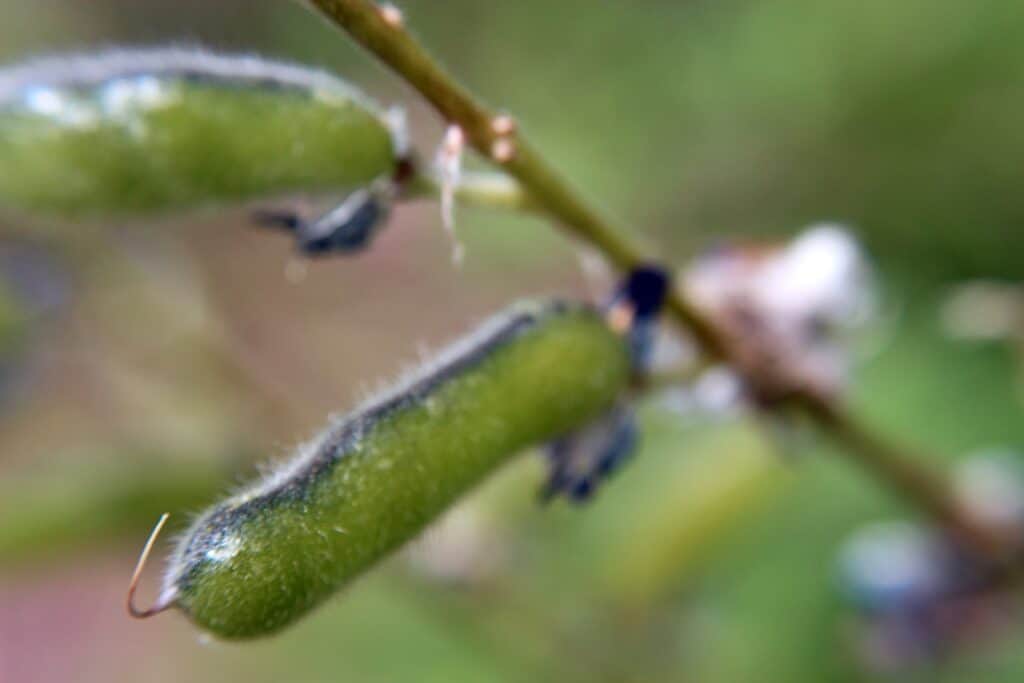
Get Out of the Campground for a Few Hours
If you or your kids are getting restless and stir-crazy, venture outside of your campground to try nearby activities or attractions. While camping itself can be the destination and the purpose of the trip, it can also be part of a larger vacation with planned activities like national park tours, museum visits, or even visits to theme parks and cities. Even a simple trip- such as a visit to a playground or grocery store, can be enough to give everyone a break and reset.
